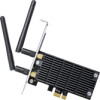TP-Link AC1300 Archer T6E V1 User Guide - Page 50
Appendix A: Specifications, Normal, Environmental and Physical - mbps
 |
View all TP-Link AC1300 manuals
Add to My Manuals
Save this manual to your list of manuals |
Page 50 highlights
Archer T6E AC1300 Wireless Dual Band PCI Express Adapter User Guide Appendix A: Specifications Normal Interface Standards Operating System Throughput Radio Data Rate Modulation Media Access Protocol Data Security Frequency* Spread Spectrum Safety & Emissions PCI Express x1 IEEE802.11ac; IEEE802.11a; IEEE802.11b; IEEE802.11g; IEEE802.11n; IEEE802.11e; IEEE802.1x; IEEE802.11i Windows XP, Windows 7, Windows 8, Windows 8.1 2.4GHz: 400Mbps (Maximal) 5GHz: 867 Mbps (Maximal) 11a: 6/9/12/18/24/36/48/54Mbps 11b: 1/2/5.5/11Mbps 11g: 6/9/12/18/24/36/48/54Mbps 11n: 400Mbps (2.4GHz), 300Mbps (5GHz) 11ac: 867 Mbps (5GHz) 11a: QPSK,BPSK,16-QAM,64-QAM 11b: QPSK,BPSK 11g: QPSK,BPSK,16-QAM,64-QAM 11n: QPSK,BPSK,16-QAM,64-QAM,256-QAM 11ac: QPSK,BPSK,16-QAM,64-QAM,256-QAM CSMA/CA with ACK WEP, WPA / WPA2, WPA-PSK / WPA2-PSK 2.4 ~ 2.4835 GHz, 5.180 ~ 5.240 GHz, 5.260 ~ 5.320 GHz, 5.500~5.580 GHz, 5.660~5.700 GHz, 5.745 ~ 5.825 GHz Direct Sequence Spread Spectrum (DSSS) FCC, CE, WIFI, IC, NCC, WHQL Environmental and Physical Working Temperature 0℃~40℃ (32℉~104℉) Storage Temperature Working Humidity Storage Humidity -40℃~70℃ (-40℉~158℉) 10% ~ 90% RH, Non-condensing 5% ~ 90% RH, Non-condensing * 1. Only 2.412GHz~2.462GHz is allowed to be used in USA, which means only channel 1~11 is available for American users to choose. * 2. Rules on the use of 5GHz band channels may vary according to different national laws. 41












